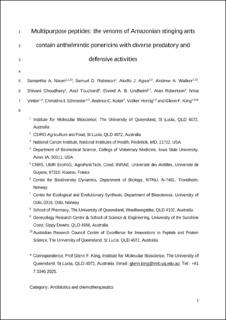| dc.contributor.author | Nixon, Samantha A. | |
| dc.contributor.author | Robinson, Samuel D. | |
| dc.contributor.author | Agwa, Akello J. | |
| dc.contributor.author | Walker, Andrew A. | |
| dc.contributor.author | Choudhary, Shivani | |
| dc.contributor.author | Touchard, Axel | |
| dc.contributor.author | Undheim, Eivind Andreas Baste | |
| dc.contributor.author | Robertson, Alan | |
| dc.contributor.author | Vetter, Irina | |
| dc.contributor.author | Schroeder, Christina I. | |
| dc.contributor.author | Kotze, Andrew C. | |
| dc.contributor.author | Herzig, Volker | |
| dc.contributor.author | King, Glenn F. | |
| dc.date.accessioned | 2022-10-24T11:13:44Z | |
| dc.date.available | 2022-10-24T11:13:44Z | |
| dc.date.created | 2021-10-05T17:40:42Z | |
| dc.date.issued | 2021 | |
| dc.identifier.citation | Biochemical Pharmacology. 2021, 192 1-16. | en_US |
| dc.identifier.issn | 0006-2952 | |
| dc.identifier.uri | https://hdl.handle.net/11250/3027884 | |
| dc.description.abstract | In the face of increasing drug resistance, the development of new anthelmintics is critical for controlling nematodes that parasitise livestock. Although hymenopteran venom toxins have attracted attention for applications in agriculture and medicine, few studies have explored their potential as anthelmintics. Here we assessed hymenopteran venoms as a possible source of new anthelmintic compounds by screening a panel of ten hymenopteran venoms against Haemonchus contortus, a major pathogenic nematode of ruminants. Using bioassay-guided fractionation coupled with liquid chromatography-tandem mass spectrometry, we identified four novel anthelmintic peptides (ponericins) from the venom of the neotropical ant Neoponera commutata and the previously described ponericin M−PONTX−Na1b from Neoponera apicalis venom. These peptides inhibit H. contortus development with IC50 values of 2.8–5.6 μM. Circular dichroism spectropolarimetry indicated that the ponericins are unstructured in aqueous solution but adopt α-helical conformations in lipid mimetic environments. We show that the ponericins induce non-specific membrane perturbation, which confers broad-spectrum antimicrobial, insecticidal, cytotoxic, hemolytic, and algogenic activities, with activity across all assays typically correlated. We also show for the first time that ponericins induce spontaneous pain behaviour when injected in mice. We propose that the broad-spectrum activity of the ponericins enables them to play both a predatory and defensive role in neoponeran ants, consistent with their high abundance in venom. This study reveals a broader functionality for ponericins than previously assumed, and highlights both the opportunities and challenges in pursuing ant venom peptides as potential therapeutics. | en_US |
| dc.language.iso | eng | en_US |
| dc.publisher | Elsevier | en_US |
| dc.rights | Attribution-NonCommercial-NoDerivatives 4.0 Internasjonal | * |
| dc.rights.uri | http://creativecommons.org/licenses/by-nc-nd/4.0/deed.no | * |
| dc.title | Multipurpose peptides: The venoms of Amazonian stinging ants contain anthelmintic ponericins with diverse predatory and defensive activities | en_US |
| dc.type | Peer reviewed | en_US |
| dc.type | Journal article | en_US |
| dc.description.version | acceptedVersion | en_US |
| dc.source.pagenumber | 1-16 | en_US |
| dc.source.volume | 192 | en_US |
| dc.source.journal | Biochemical Pharmacology | en_US |
| dc.identifier.doi | 10.1016/j.bcp.2021.114693 | |
| dc.identifier.cristin | 1943554 | |
| dc.relation.project | Norges forskningsråd: 287462 | en_US |
| cristin.ispublished | true | |
| cristin.fulltext | postprint | |
| cristin.qualitycode | 1 | |

